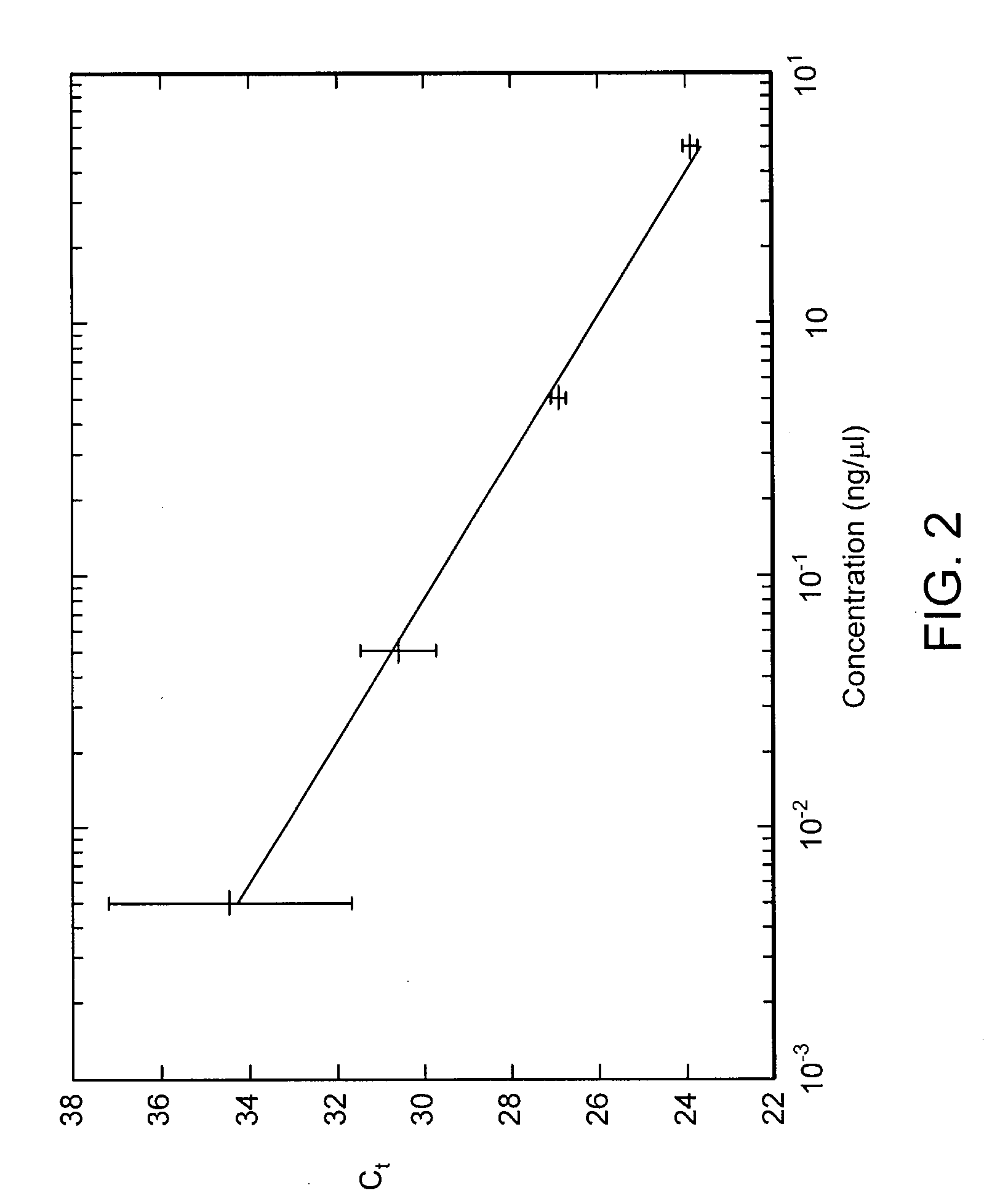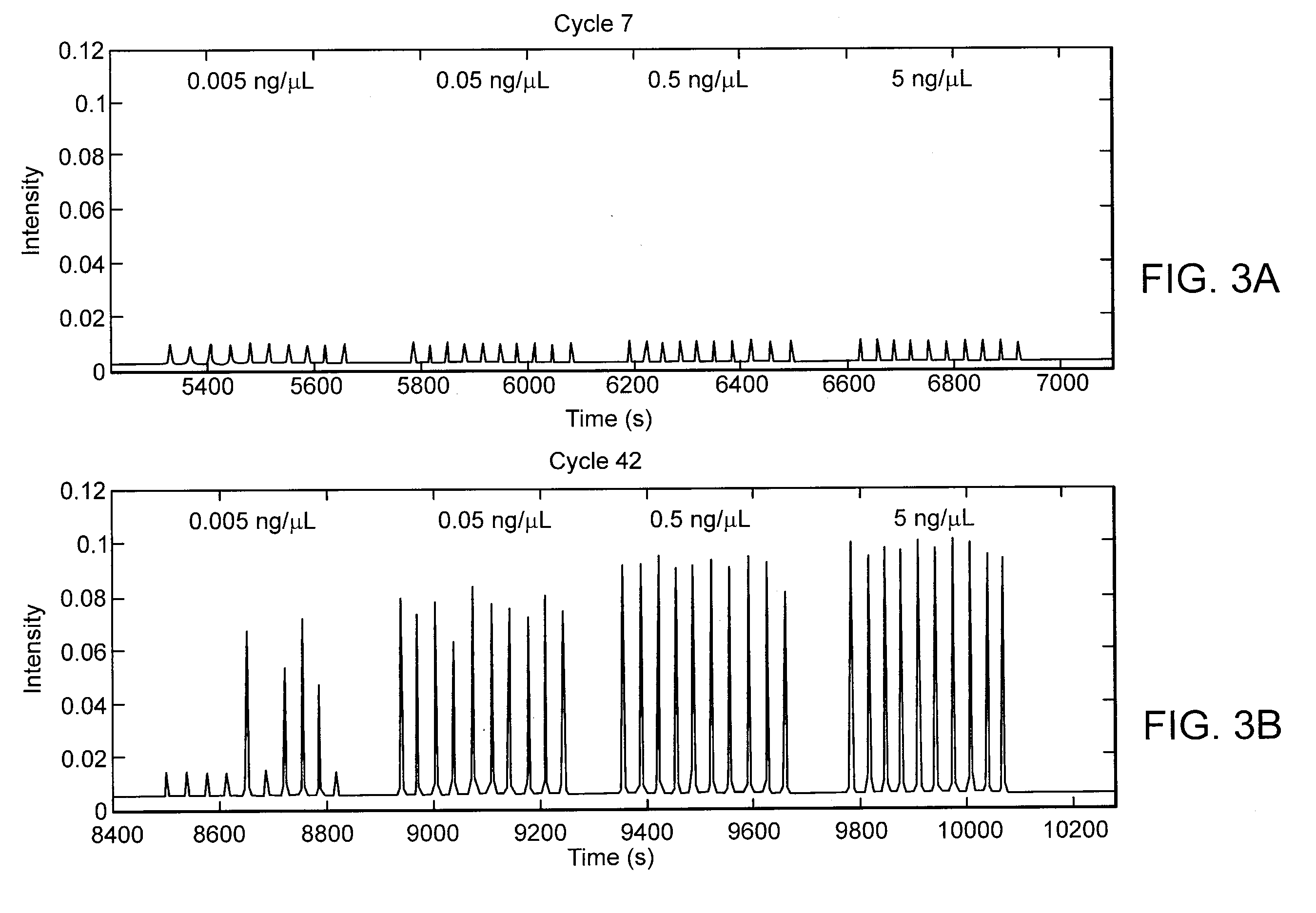Methods and devices for digital PCR
a nucleic acid amplification and digital technology, applied in biochemistry apparatus and processes, fluid controllers, laboratory glassware, etc., can solve the problems of increasing the sensitivity of amplification to biochemical surface absorption problems, introducing significant variability and losses, and large number of blank segmented volumes
- Summary
- Abstract
- Description
- Claims
- Application Information
AI Technical Summary
Benefits of technology
Problems solved by technology
Method used
Image
Examples
example 1
Measurement of qPCR Amplification Efficiency by Serial Dilution
[0044]Total RNA is extracted from cultured cells, reverse transcribed into cDNA and used as the template for the qPCR reaction. The starting concentration of the template is 5 ng / μl which is then diluted 10-fold to 0.5 ng / μl. This 10-fold dilution is repeated yielding samples with four concentrations of cDNA template: 5 ng / μl, 0.5 ng / μl, 0.05 ng / μl, and 0.005 ng / μl. The resulting amplification curves, obtained using a Stokes Bio device (www.stokesbio.ie), are shown in FIG. 1. As seen from the figure, for lower starting template concentrations, more cycles of PCR are necessary to bring the fluorescence signal to the threshold level. In fact, if the PCR reaction was 100% efficient a 0.5 ng / μl sample would require 3.32 more cycles of PCR to reach the same threshold as a 5 ng / μl sample (10 times the 0.5 ng / μl sample). The fractional cycle at which the amplification curve reaches the threshold is called the Ct value: a measur...
example 2
High Throughput qPCR Performance Validation
[0046]The analysis of gene expression is an essential element of functional genomics, and qPCR-based expression profiling is the gold standard for the precise monitoring of selected genes. Gene expression relies upon the reverse transcription of mRNA to cDNA. It is, however, generally not possible to use cDNA as a standard for absolute quantification of mRNA because there is no control for the efficiency of the reverse transcription step. This Example presents Stokes Bio's amplification representative performance data from genomic DNA (gDNA), a commonly used in standard qPCR.
[0047]A TaqMan® RNase P gene primer and probe set is used to evaluate instrument performance. The RNase P gene is a single-copy gene encoding the RNA moiety for the RNase P enzyme. Several two-fold dilutions are created from a stock of a known gDNA copy number. These dilutions were used to prepare complete qPCR reactions for amplification in the Stokes Bio instrument. T...
example 3
Digital PCR End-Point Detection
[0048]The premise for this technique is to divide a large volume into a discreet number of smaller volumes reducing the number of copies in each sample, following the amplification process to perform fluorescence detection on the emerging droplets. The resulting total number of droplets with amplification can then be used to determine starting copy number. It also can be used for rare target detection wherein the statistic probability of amplification is increased for the rare target as the number of background molecules is reduced by the division.
[0049]Using a statistical prediction model the probability of the distributed target molecules in the segment droplets can be generated. This is particularly of benefit for low concentration samples as it provides a prediction of the number of droplets containing molecules and thus the number of droplets expected to fluoresce.
[0050]The binomial distribution model employed is a discrete probability distributio...
PUM
| Property | Measurement | Unit |
|---|---|---|
| volume | aaaaa | aaaaa |
| volume | aaaaa | aaaaa |
| volume | aaaaa | aaaaa |
Abstract
Description
Claims
Application Information
 Login to View More
Login to View More - R&D
- Intellectual Property
- Life Sciences
- Materials
- Tech Scout
- Unparalleled Data Quality
- Higher Quality Content
- 60% Fewer Hallucinations
Browse by: Latest US Patents, China's latest patents, Technical Efficacy Thesaurus, Application Domain, Technology Topic, Popular Technical Reports.
© 2025 PatSnap. All rights reserved.Legal|Privacy policy|Modern Slavery Act Transparency Statement|Sitemap|About US| Contact US: help@patsnap.com



